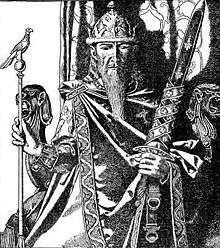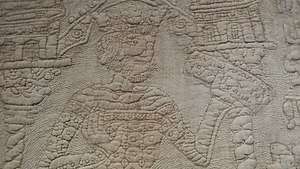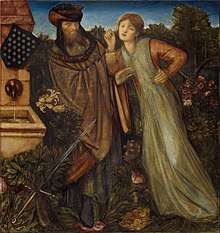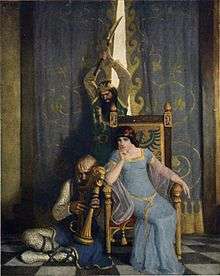Mark of Cornwall
Mark of Cornwall (Latin: Marcus, Cornish: Margh, Welsh: March, Breton: Marc'h) was a king of Kernow (Cornwall) in the early 6th century. He is most famous for his appearance in Arthurian legend as the uncle of Tristan and husband of Iseult, who engage in a secret affair.

King Mark

In Old Welsh records, Mark is recorded as "March son of Meirchion" and is variously associated with North Wales, South Wales or South-West Scotland. Some identify King Mark with King Conomor of Dumnonia.
In Wrmonoc of Landévennec's Life of St. Pol de Leon, he refers to a "King Marc whose other name is Quonomorus." Also rendered Cunomorus, this name means literally the 'Hound-of-the-sea'.[1] An inscription on a 6th-century gravestone near the Cornish town of Fowey memorializes (in Latin) a certain "Drustanus son of Cunomorus" and it has been conjectured that this is the "Tristan son of Mark (alias 'Quonomorus')" of legend.[2]
There is a monument believed by some to refer to Tristan ("Drustanus") at grid reference SX112521. The Tristan Stone is a granite pillar near Fowey, Cornwall, originally situated at Castle Dore. The stone has a mid-6th-century two line inscription which has been interpreted as reading DRVSTANVS HIC IACIT CVNOWORI FILIV'S ("Drustan lies here, of Cunomorus the son"). A now missing third line was described by the 16th century antiquarian John Leland as reading CVM DOMINA OUSILLA ("with the lady Ousilla"). Ousilla is a Latinisation of the Cornish female name Eselt.[3] The stone led to Mark's association with Castle Dore.
In the legend
In most versions of the story of Tristan and Iseult, King Mark of Cornwall is Tristan's uncle. His sister is Tristan's mother, Blancheflor alias Elizabeth/Isabelle, or, in some later versions, he is related to Tristan's father, Meliadus.

Mark sends Tristan as his proxy to fetch his young bride, the Princess Iseult, from Ireland. Tristan and Iseult fall in love, and, with the help of a magic potion, proceed to have one of the stormiest love affairs in medieval literature. Mark suspects the affair and eventually his suspicions are confirmed. In some versions, he sends for Tristan to be hanged, and banishes Iseult to a leper colony. Tristan escapes the hanging and rescues Iseult from her confinement. Mark later discovers this and eventually forgives them, with Iseult returning to Mark and Tristan leaving the country. The story is cyclical with Mark suspecting Tristan and Iseult of adultery and then believing they were innocent. This happens again and again in the story. In Béroul's version, Tristan and Iseult are never in grave danger due to the narrator's declaration that he himself and God were on their side. King Mark, in the role of husband, is not portrayed as idealistic as other kings in Arthurian literature who were only portrayed in the role of king and not the personal role of husband.
Marie de France's Breton lai Chevrefoil (titled sometimes as The Lay of the Honeysuckle) tells a part of the Tristan and Iseult tale. The lai begins with an explanation that Mark was enraged with Tristan's affair with his wife, and thus banished him from Cornwall. Tristan spends a year in his own land of South Wales, pining away for Isoude. Eventually, his sorrow grew so great that he went against Mark's order and hid in the woods of Cornwall, taking shelter with villagers only at night. Eventually Tristan comes to hear that Mark plans to hold a feast for Pentecost, and that Isoude would be riding through the forest to attend. He finds the path the queen is most likely to take, and lays on it a hazel stick he stripped the bark off of and carved his name into. Isoude recognizes the sign and stops her party to rest, sneaking away with her maid Brangwaine to see Tristan. During this illicit meeting, Isoude helps Tristan with a plan to win back the favor of King Mark. Marie de France ends the poem by telling the reader that the lai Tristan composed was called "Goatleaf" in English or "Chèvrefeuille" in French, and that the very lai he composed was the one the reader just finished.[4]

"King Mark slew the noble knight Sir Tristram as he sat harping before his lady la Belle Isolde."
In the Prose Tristan, Mark's character deteriorates from a sympathetic cuckold to a downright villain. He rapes his niece and then murders her when she produces his son, Meraugis. He murders his brother Baldwin as well. In earlier versions of the story, Tristan dies in Brittany, far away from Mark; but in the Prose Tristan, Mark stabs Tristan while he plays the harp under a tree for Iseult. This version of Mark's character was popular in other medieval works, including the Romance of Palamedes and Thomas Malory's Le Morte d'Arthur. In these, Mark is usually seen as ruling Cornwall from Tintagel Castle and is often a sworn enemy of Arthur's jester knight Dinadan and (as in the Post-Vulgate Cycle) even the destroyer of Camelot after the death of Arthur.
Horse's ears
Mark has become associated with a Celtic variant of the story of Midas and his donkey ears from Greek mythology, due to a pun on marc which is a Celtic word for "horse".[5] The episode already occurs in Tristan by the 12th century French poet Béroul, where the dwarf divulges the secret that "Mark has horse's ears" addressing a hawthorn tree, in the presence of three lords.[5]
There is a Breton legend which appeared in print in 1794, in which March was initially the king of Cornouaille, France, seated at Ploumarch (Portzmarch).[lower-alpha 1][6] The king kills every barber who knows the secret about his ears, except one, who speaks the secret into the sand.[6] (or wind[7]). Reeds subsequently grow from that spot, and the plants are harvested to make into reeds for the oboe (or simply make pipes[7]). When the instruments are played, it sounds to the audience as if the music is saying the king has horse's ears.[6][7] John Rhys recorded a Welsh tale that differs little from the simpler Breton version.[lower-alpha 2][8]
An embellished version collected by Yann ar Floc'h (1905) blends the legend of Ys, with the premise that Marc was condemned by Gradlon's daughter Ahès (or Dahut[9]). March tried to hunt her when she was assuming the guise of a doe and had his ears exchanged with those of his prized horse Morvarc'h.[10][9]
In modern culture
- King Mark takes on a much more gruesome role in Alfred, Lord Tennyson's poetry cycle Idylls of the King. While Arthur and many of his knights are away taking on the court of the Red Knight, Lancelot is called upon to judge "The Tournament of the Dead Innocence." The tournament quickly becomes a mockery, full of insults and broken rules. Tristram (that is, Tristan) is the winner of the tournament, winning all of the rubies from the necklace. Tristram then breaks tradition in presenting the rubies to a woman present, saying instead "This day my Queen of Beauty is not here." This enrages the crowd, with many saying that "All courtesy is dead," and "The glory of our Round Table is no more." Tristram, who in this piece married Isolt of the White Hands, carries his winnings instead to Mark's wife Queen Isolt, who is upset that Tristram married another woman. The two mock each other for a brief period before Tristram at last puts the necklace about Isolt's neck, and leans down to kiss her. Just as his lips touch her, Mark makes his appearance, rising up behind Tristram and cleaving him through the brain.[11]
- Mark (called "Marke") is a character in Wagner's 1859 opera Tristan und Isolde, a role created by the bass Ludwig Zottmayer.
- In the 1954 film The Black Knight he is portrayed as a pagan looking to overthrow Christianity and King Arthur by Patrick Troughton.
- In the 1970s TV show Arthur of the Britons, Mark was played by Brian Blessed.[12]
- In 1981 film Lovespell he was played by Richard Burton (as King Mark of Cornwall).[13]
- Mark (called "Marc'h of Kernow")[14] is a character in Diana L. Paxson's 1988 novel The White Raven. The book consists of Paxson's take on the Tristan and Iseult story, told from the point of view of Iseult's cousin Branwen.[15]
- In Bernard Cornwell's 1996 novel Enemy of God in his The Warlord Chronicles series, King Mark is a physically and morally monstrous tyrant who apparently keeps murdering his young wives every few years in order to marry another. When Mark's newest teenage wife Iseult flees with own his young son Tristan, the fugitive lovers take refugee in Mordred's kingdom of Dumnonia under the regency of Tristan's friend Arthur. In an agonizing choice, Arthur allows Mark to arrive with his soldiers and have the prince killed and the queen sadistically burned at the stake. Mark himself later dies from a horrible illness.
- In the 2006 film Tristan & Isolde, Marke was played by Rufus Sewell. He adopts Tristan as his son after the death of the boys' parents, who loyally supported Marke's plans to unite Britain's peoples. Marke is portrayed as a good ruler and a kind husband to Isolde, unaware that by circumstance she has already fallen for Tristan, and is confused by his adopted son's unhappy, distanced behaviour. When Tristan and Isolde are caught embracing, Marke feels angry and betrayed, but relents after hearing the full story of their meeting and gives them permission to leave together, though Tristan insists on staying to stand against Marke's mobilising enemies. After Tristan is mortally wounded in battle, Marke takes him back to Isolde to share his last moments with her, then goes on to successfully unite Britain.[16]
Notes
- He is only known as the "king of Portzmarch", not as Mark, in Cambry's version of 1794.
- The reeds sprang from the place where all the king's victims were buried.
References
- Citations
- Thomas, Charles (1986) Celtic Britain. London: Thames & Hudson ISBN 0-500-02107-4; p. 70
- "Tristan Stone [Longstone] Early Christian Sculptured Stone". The Megalithic Portal.
- Craig Weatherhill, Cornovia: Ancient sites of Cornwall and Scilly 4000 BC – 1000 AD.
- "French Mediaeval Romances from the Lays of Marie de France". Project Gutenberg.
- Sargent-Baur, Barbara N. (2015), The Romance of Tristran by Beroul and Beroul II: Student Edition and English Translation, University of Toronto Press, pp. 35–37 (vv. 1306–50), and endnote, p. 127
- Cambry, F., Voyage dans le Finistere en 1749, II, 287; cited by Loomis (1950), pp. 290–291
- Wood, Charles W. (1891). "The Bretons at Home". The Argosy. 52: 226.CS1 maint: ref=harv (link)
- Rhys, John (1901). Celtic Folklore: Welsh and Manx. 1. Oxford: Oxford University Press. pp. 233–234.
- Brékilien, Yann (1973). Le roi Marc'h aux oreilles de cheval. Contes et légendes du pays breton. Nature et Bretagne. pp. 37–.CS1 maint: ref=harv (link)
- Milin, Gaël (1991). Le roi Marc aux oreilles de cheval. Librairie Droz. pp. 245–252.CS1 maint: ref=harv (link)
- Tennyson, Alfred (1983). "The Last Tournament". In Gray, J. M. (ed.). Idylls of the King. Penguin Books. pp. 248–268. ISBN 978-0-140-42253-5.
- "Arthur of the Britons (TV Series 1972-1973) - Full Cast & Crew". IMDb.
- "Lovespell (1981) - Full Cast & Crew". IMDb.
- "The White Raven: Diana L. Paxson: 9780688074968: Amazon.com: Books". Amazon.com.
- Paxson, Diana. "Historical and Mythic Fantasy". diana-paxson.com/.
- "Tristan + Isolde (2006) - Full Cast & Crew". IMDb.
- Bibliography
- Loomis, Roger S. (1950). "Breton Folklore and Arthurian Romance". Comparative Literature. 4 (2): 289–306. JSTOR 1768387.CS1 maint: ref=harv (link)
- Marie de France (trans. Eugene Mason) [1911]. “The Lay of the Honeysuckle”, French Mediaeval Romances from the Lays of Marie de France by Marie at Project Gutenberg
- Sir Thomas Malory. “Book VIII”, Le Morte d'Arthur: Volume 1 at Project Gutenberg
- Alfred, Lord Tennyson [1996]. “The Last Tournament”, Idylls of the King at Project Gutenberg
External links
| Wikimedia Commons has media related to King Mark of Cornwall. |
- Mark at The Camelot Project
| Legendary titles | ||
|---|---|---|
| Preceded by Felix |
King of Cornwall | Unknown |